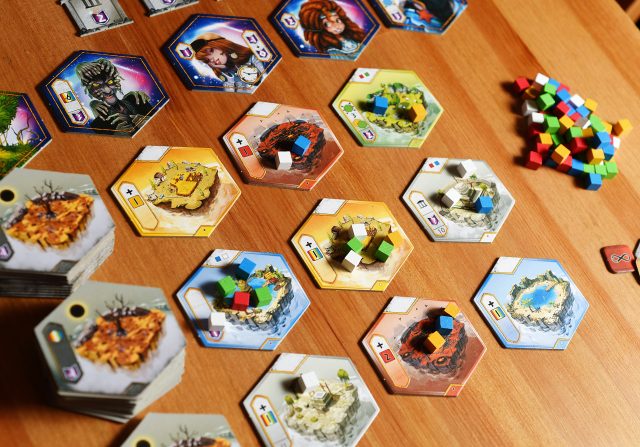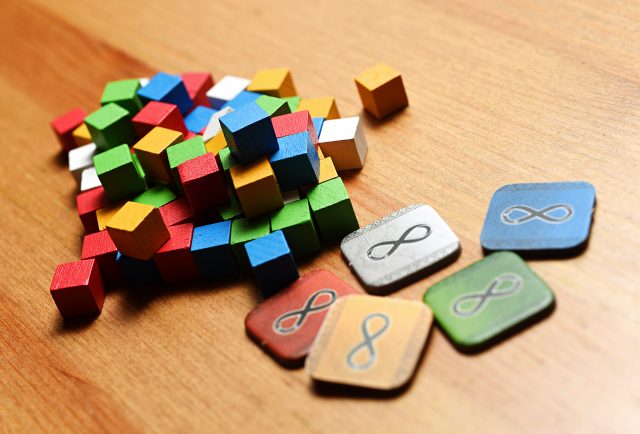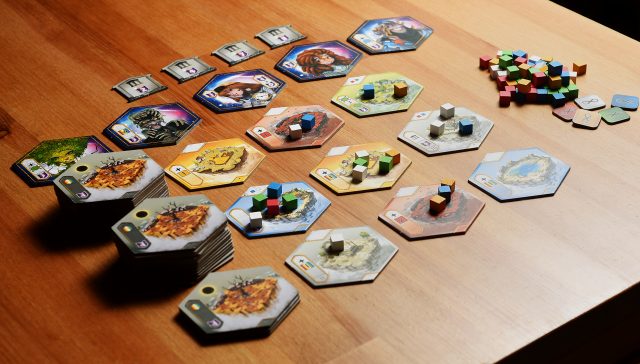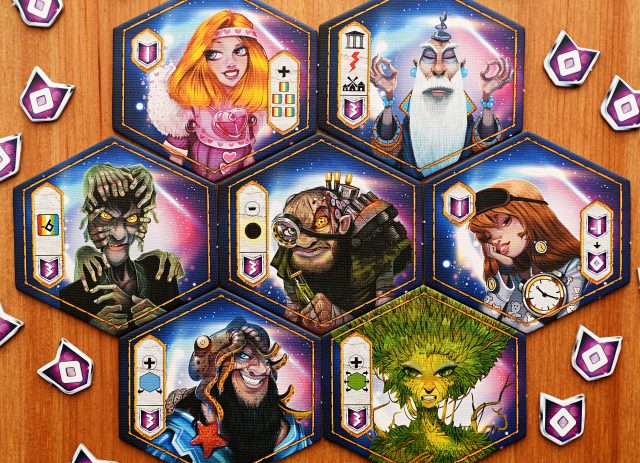The work of an almighty God or Goddess is never done. Creating new worlds, gaining the devotion of Worshipers, picking the kids up after daycare, it never ends! At least at the end of the day, you get to sit back and enjoy the beauty of your hard work. In Orbis, you are building a whole new world made up of different lands. Will you be able to create a beautiful location, and earn the love of the people? Clever choices, timing, and a little bit of luck will make all the difference.
 There aren’t many games by Space Cowboys that I don’t really enjoy. I recently replayed Splendor, and I had forgotten the simple pleasures that game entails. T.I.M.E. Stories is still one of my all time favs, and I like to try out the new scenarios whenever I get the chance. And Elysium is a game with endless replayability and an intriguing economic system. That’s just a few of their titles that come to mind, but needless to say, they have a reputation that is hard to beat for me. So, it’s no big surprise that I was pretty excited to get to try out their new title, Orbis.
There aren’t many games by Space Cowboys that I don’t really enjoy. I recently replayed Splendor, and I had forgotten the simple pleasures that game entails. T.I.M.E. Stories is still one of my all time favs, and I like to try out the new scenarios whenever I get the chance. And Elysium is a game with endless replayability and an intriguing economic system. That’s just a few of their titles that come to mind, but needless to say, they have a reputation that is hard to beat for me. So, it’s no big surprise that I was pretty excited to get to try out their new title, Orbis.
Orbis is played over 15 rounds. The winner is the one who is able to earn the most Creation Points from the world they create. Each turn, you will select one of the available nine face up Lands to add to your growing world, or, one time in a game, you’ll select one of the available God tiles (I assume since we’re playing Gods, they are going to be like some sort God buddy that will hang out with us and compliment our world building skills).
 The worlds we make will take on a pyramid-like shape, with a base of five land tiles, a second level of four, then three, and finally two. You can cap your pyramid with you God tile, but it’s purely aesthetic.
The worlds we make will take on a pyramid-like shape, with a base of five land tiles, a second level of four, then three, and finally two. You can cap your pyramid with you God tile, but it’s purely aesthetic.
The Land tiles are separated into level one, two, and three. They’re sorted and piled by number and then nine level one tiles form the available grid to start the game. Once tiles are selected, they are replaced by a level one tile until those run out, you then move on to level two and three in order.
You don’t have to complete a full level before building higher in your pyramid, however there are some placement restrictions. Hey, even Gods have rules. Your first row of lands can be of any colour. They just have to form a connected structure. As you move up, each Land tile must be supported by two tiles below it, and at least one of those tiles must match its colour. There may be times when those rules are impossible, but we’ll come back to that situation.
 Now what would a God be without Worshipers? Not too impressive, I can tell you that. No one starts with any Worshipers, but you’ll start gaining them pretty darn quick. When a Land tile is taken from the 3×3 grid, it’s going to generate some Worshipers of its colour on the orthogonally adjacent tiles. So, when a blue Land tile is taken, all adjacent tiles get one blue Worshiper. These will build up quickly, and tiles you might not have had an interest in before will start to become attractive with their wealth of worship attached to them. When you take a tile with Worshipers they are added to your supply to a max of ten at the end of your turn. Some Land tiles also produce Worshipers for you, indicating the colour and number that you get when you place it.
Now what would a God be without Worshipers? Not too impressive, I can tell you that. No one starts with any Worshipers, but you’ll start gaining them pretty darn quick. When a Land tile is taken from the 3×3 grid, it’s going to generate some Worshipers of its colour on the orthogonally adjacent tiles. So, when a blue Land tile is taken, all adjacent tiles get one blue Worshiper. These will build up quickly, and tiles you might not have had an interest in before will start to become attractive with their wealth of worship attached to them. When you take a tile with Worshipers they are added to your supply to a max of ten at the end of your turn. Some Land tiles also produce Worshipers for you, indicating the colour and number that you get when you place it.
 So now that you have the love and devotion of a diverse group of people, what are you going to do with it? Well, level one Land tiles usually come at no cost, but as you proceed through the game, some of the more attractive ones will force you to cash in your Worshipers to acquire them. Some have specific colour requirements, others will ask for Worshipers of any colour. If you’re ever short of a certain colour for a tile, you can substitute three of any one colour as a replacement.
So now that you have the love and devotion of a diverse group of people, what are you going to do with it? Well, level one Land tiles usually come at no cost, but as you proceed through the game, some of the more attractive ones will force you to cash in your Worshipers to acquire them. Some have specific colour requirements, others will ask for Worshipers of any colour. If you’re ever short of a certain colour for a tile, you can substitute three of any one colour as a replacement.
There are some specific Land tiles that can give you an advantage or earn you end game points. Farms reward the owner with a Reduction token, allowing them to ignore a certain colour when paying for the costs of Land tiles. Forest and Irrigation tiles earn you points if your world is constructed in a certain way. Villages and Volcanoes will force you to discard Worshipers from either your supply or the grid to validate them and earn you end game points. Finally, there are Temples. They have a number and a number of Temple icons on them. At the end of the game, the person with the most Temple icons gains the highest Temple token, followed by the next person and so on. They range from two points to 11 (in a four-player game), so it can be worth pursuing for sure. If there is a tie, the player with the higher number on their Temple tiles wins the tie.
 As I mentioned, there may be times in a game when you either can’t or don’t want to pay for the cost of a tile. In that case, you’ll still take one gaining the accumulated Worshipers on it, but you will place it in your structure facedown as a Wilderness. For each one you have in your world at the end of the game, you’ll lose one point, which stinks, however Wilderness count as any colour, meaning they can allow you to build colours you had been previously cut off from or they can earn you points by fulfilling the requirements of other tiles. In my experience, it’s not uncommon to end up with at least one Wilderness in your world at the end of the game. Suck it up and use it to your advantage.
As I mentioned, there may be times in a game when you either can’t or don’t want to pay for the cost of a tile. In that case, you’ll still take one gaining the accumulated Worshipers on it, but you will place it in your structure facedown as a Wilderness. For each one you have in your world at the end of the game, you’ll lose one point, which stinks, however Wilderness count as any colour, meaning they can allow you to build colours you had been previously cut off from or they can earn you points by fulfilling the requirements of other tiles. In my experience, it’s not uncommon to end up with at least one Wilderness in your world at the end of the game. Suck it up and use it to your advantage.
In one of the 15 rounds, you’re going to take one of the God tiles in the game. There are ten in the box, but in a four-player game you’ll use only five. Of course, the sooner you take a God, the more options you’ll have, but many of them will reward you with points based on the construction of your world, so it might make more sense to wait and see if you fulfill their requirements before snagging them. The God of Death asks you to discard six Worshipers to earn three end game points. The Goddess of Fire will give you three points if you have among the most validated Volcanoes. The Goddess of Love immediately earns you five Worshipers and an end game point. The God of Technology give you three points if you have amongst the least Wildernesses at game end.
 Based on the which God tiles come up and the order the Land tiles appear, there is a wide variety in the approaches you can take to a game of Orbis. You are going to feel the tension as a tile you want comes up, and you have to wait and hope that it’s still there when your turn comes around. There is a small sense of multi-player solitaire, but while you are doing your own thing, you’re very much interested in the moves of the other players. They may have built themselves into a corner, or they may be pursuing the same strategy as you, so you can’t sleep on anyone’s moves.
Based on the which God tiles come up and the order the Land tiles appear, there is a wide variety in the approaches you can take to a game of Orbis. You are going to feel the tension as a tile you want comes up, and you have to wait and hope that it’s still there when your turn comes around. There is a small sense of multi-player solitaire, but while you are doing your own thing, you’re very much interested in the moves of the other players. They may have built themselves into a corner, or they may be pursuing the same strategy as you, so you can’t sleep on anyone’s moves.
I’m going to go ahead and say that Orbis is a heck of a lot of fun. It’s a game whose rules are simple, turns are relatively quick, and there is a certain element of luck. At the end of it, you’ll be replaying where things went wrong or right for you, and you’ll be dying to rack them up and play again. This is the first game I’ve played by designer Tim Armstrong, but I get the feeling I will be looking forward to his next title, much in the same way I look forward to the next Space Cowboys game.
Thanks to Space Cowboys and Asmodee for providing a review copy of Orbis for this article.
Comments
No comments yet! Be the first!